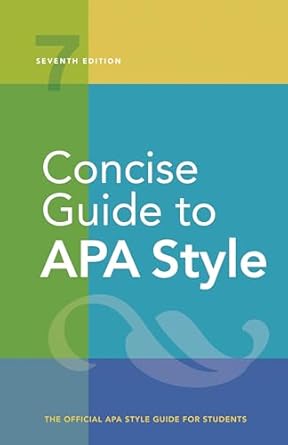[toc]
academic citations mastering reports ethics grants
Concise Guide to APA Style: 7th Edition (OFFICIAL)
Page 291 Review
Understanding Citations: A Deep Dive into Academic References
This excerpt provides a glimpse into the meticulous world of academic referencing, specifically focusing on examples of citing annual reports, codes of ethics, and grants.
It adheres to a specific citation style, likely APA, emphasizing both parenthetical and narrative citations.
Let’s break down each example to understand the nuances of proper attribution.
Annual Reports: Citing Organizational Publications
The first example showcases how to cite an annual report from a governmental agency:
“U.
S.
Securities and Exchange Commission. (2017).
Agency financial report: Fiscal year 2017. https://www.sec.gov/files/sec-2017-agency-financial-report.pdf
Parenthetical citation: (U.S.
Securities and Exchange Commission, 2017)
Narrative citation: U.S.
Securities and Exchange Commission (2017)”
Here’s what we can glean from this:
* **Authorship:** When citing organizational reports, the issuing body (U.
S.
Securities and Exchange Commission) is treated as the author.
* **Date:** The year of publication (2017) is crucial for indicating the report’s relevance and currency.
* **Title:** The full title, “Agency financial report: Fiscal year 2017,” is accurately presented.
* **Source:** The URL provides direct access to the report, enhancing transparency and verifiability.
* **Parenthetical vs.
Narrative:** The excerpt demonstrates the difference between placing the citation in parentheses at the end of a sentence and incorporating the author directly into the sentence’s narrative.
Codes of Ethics: Referencing Professional Standards
Next, we see examples of citing codes of ethics from various professional organizations:
“American Counseling Association. (2014). 2014 ACA code of ethics. https://www.counseling.org/knowledge-center
American Nurses Association. (2015).Code of ethics for nurses with interpretive statements. https://www.nursingworld.org/coe-view-only
American Psychological Association. (2017).Ethical principles of psychologists and code of conduct (2002, amended effective June 1, 2010, and January 1, 2017). https://www.apa.org/ethics/code/index.aspx
Parenthetical citations: (American Counseling Association, 2014; American Nurses Association, 2015; American Psychological Association, 2017)
Narrative citations: American Counseling Association (2014), American Nurses Association (2015), and American Psychological Association (2017)”
Key observations:
* **Multiple Authors:** When citing multiple sources in the same parenthetical citation, they are separated by semicolons.
* **Amendment Dates:** The APA citation highlights the importance of including amendment dates for documents that have been updated.
This ensures the reader is aware of the specific version being referenced.
* **Accessibility:** Providing URLs allows readers to easily access and review the complete code of ethics.
Grants: Acknowledging Funding Sources
The final example illustrates how to cite a grant:
“Blair, C.
B. (Principal Investigator). (2015-2020).
Stress, self-regulation and psychopathology in middle childhood (Project No. 5RO1HD081252-04) [Grant].
Eunice Kennedy Shriver National Institute of Child Health & Human Development. https://projectreporter.nih.gov/project_info_details.cfm?aid=9473071&icde=40092311
Parenthetical citation: (Blair, 2015-2020)
Narrative citation: Blair (2015-2020)”
Important details:
* **Principal Investigator:** The principal investigator (Blair, C.
B.) is listed as the author, along with their role.
* **Project Duration:** The start and end years of the project (2015-2020) are included to indicate the timeframe of the funded research.
* **Project Number:** Including the project number (Project No. 5RO1HD081252-04) allows for precise identification of the grant.
* **Funding Agency:** The source is the funding agency (Eunice Kennedy Shriver National Institute of Child Health & Human Development).
* **Grant Application Exclusion:** The note that “A grant application is not a recoverable source and should be discussed as part of the methodology but not included in the reference list” is crucial for distinguishing between funded research and the application process itself.
General Principles of Citation
This excerpt, while concise, underscores the importance of accuracy, consistency, and clarity in academic citations.
It highlights the need to:
* **Accurately represent the source material:** The title, author, date, and source information must be meticulously recorded.
* **Adhere to a consistent citation style:** Whether APA, MLA, Chicago, or another style, consistency is paramount.
* **Provide sufficient information for retrieval:** URLs and project numbers are essential for allowing readers to locate the original source.
* **Distinguish between different types of sources:** The examples demonstrate how to cite reports, codes of ethics, and grants, each with its own specific requirements.
By following these guidelines, researchers can ensure that they are giving proper credit to the original authors and enabling others to build upon their work.
Buy full ebook for only $18: https://www.lulu.com/shop/american-psychological-association/concise-guide-to-apa-style-7th-edition-official/ebook/product-rmzpq54.html?page=1&pageSize=4
Academic Citations Mastering Reports Ethics Grants
Read more: Mastering Reference Elements: A Comprehensive Guide

